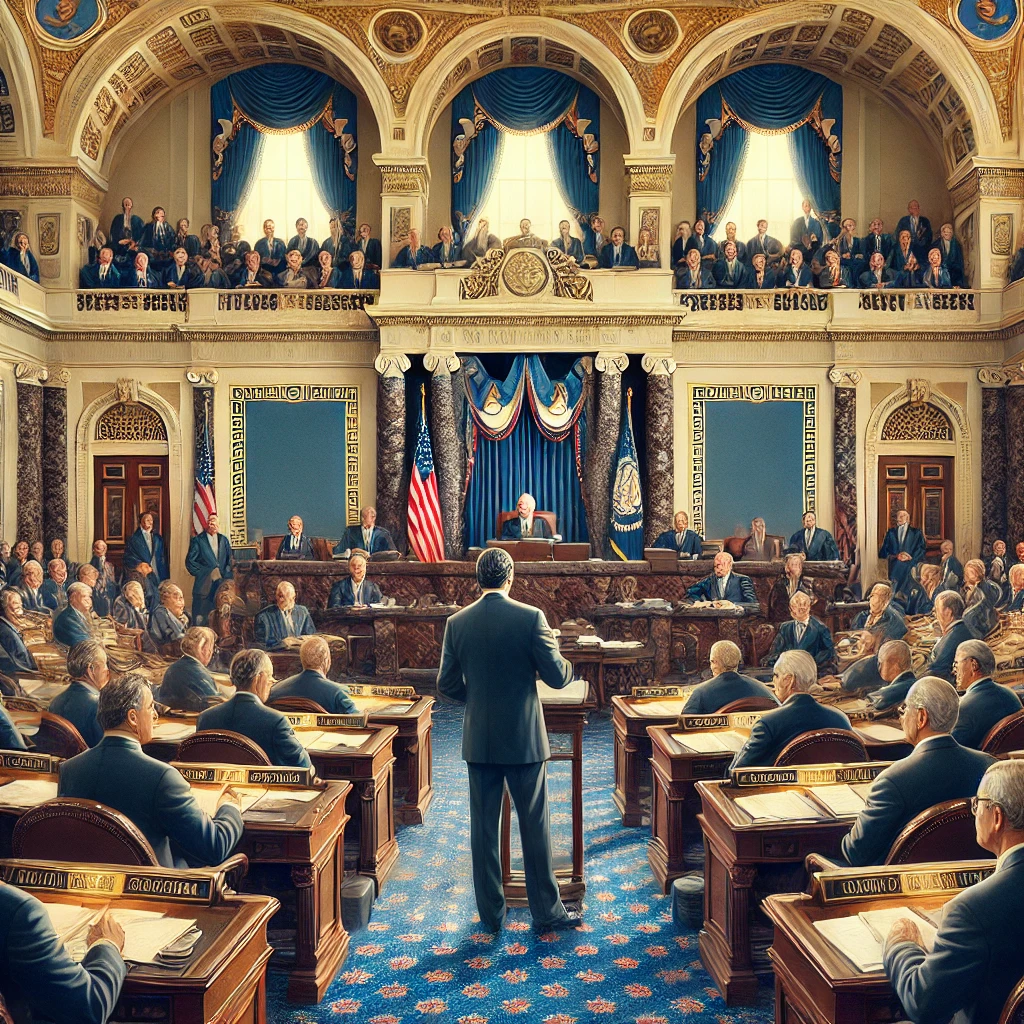The Vice President of the United States is often referred to as the second-highest executive office in the nation, but the role encompasses far more than just being a backup to the president. The vice presidency has evolved dramatically since its creation in 1787. The modern vice president is not just a ceremonial figure but a powerful figure in U.S. politics, holding significant influence in both the executive and legislative branches of the government. In this article, we will dive into the role of the Vice President of the United States, its historical context, constitutional responsibilities, and how it has evolved into a more powerful office today.
Constitutional Role of the Vice President
The Vice President of the United States has a few clearly defined duties, as set forth by the U.S. Constitution. Under Article I, Section 3, the vice president is designated as the President of the Senate. This position comes with the responsibility to preside over Senate meetings and cast a tie-breaking vote in the event of a 50-50 deadlock. However, the vice president does not typically participate in the day-to-day debates of the Senate, a responsibility generally delegated to a presiding officer known as the Senate pro tempore.
Despite the vice president’s official role in the Senate, their influence within the chamber is often minimal. In practice, the vice president presides over the Senate only during important ceremonial events or when a tie-breaking vote is required. The officeholder’s actual involvement in legislative affairs is typically limited, but their role as a tie-breaker is crucial in evenly split sessions.
Additionally, the vice president’s constitutional duty also includes presiding over the certification of Electoral College votes in presidential elections. This process ensures that the results are officially tallied and confirmed, marking a significant moment in the U.S. presidential election cycle.
History and Development of the Vice Presidency
When the U.S. Constitution was first written, the Vice President of the United States was viewed as a relatively minor position. The vice president was essentially the runner-up in the presidential election, a scenario that led to tension and rivalry among early officeholders, such as John Adams and Thomas Jefferson, who initially served as political opponents. This system, which often left the president and vice president at odds, was altered by the Twelfth Amendment in 1804, which ensured that both the president and vice president were elected on the same ticket.
Early vice presidents, like John Adams, who served from 1789 to 1797, had limited duties beyond presiding over the Senate. As political parties began to form, the role of the vice president slowly expanded. However, it wasn’t until the 20th century that the office began to gain more influence. Franklin D. Roosevelt’s vice president, Henry Wallace, for example, was given more responsibilities during World War II, and after World War II, vice presidents began to be more involved in presidential decision-making processes.
The real transformation of the vice presidency came with the election of Lyndon B. Johnson in 1960, who, after Kennedy’s assassination, stepped into the presidency and changed how the officeholder was viewed in the executive branch. As vice president, Johnson had been deeply involved in domestic and foreign policy decisions, and as president, he solidified the vice president’s evolving role as a partner in governance.
Modern-Day Vice President: A Powerful Role
Today, the Vice President of the United States is no longer seen as a ceremonial figure. The position has grown in power, largely due to the changing nature of presidential administrations and national security concerns. Vice presidents are now integral members of the president’s team, often consulted on major decisions and included in the administration’s inner circles. This transformation is a direct result of the growing complexity of modern governance.
In recent decades, vice presidents like Joe Biden, Dick Cheney, and Kamala Harris have all held significant sway within the administration. For instance, Joe Biden played a major role in U.S. foreign policy under President Barack Obama, particularly regarding issues like the Iraq War and the withdrawal of U.S. troops. Similarly, Dick Cheney wielded enormous influence during the George W. Bush administration, often taking the lead in matters of national security.
The modern vice president is also seen as a key adviser to the president, a position that allows them to influence critical policy decisions. This expanded role in the executive branch has elevated the vice presidency to a much higher level of prominence and respect than its early history suggested.
Vice Presidents Who Became Presidents
One of the most unique aspects of the Vice President of the United States is the officeholder’s potential to ascend to the presidency. Nine vice presidents have succeeded to the presidency either through death, resignation, or removal of the sitting president. Notable vice presidents who became president include Harry S. Truman, who assumed the presidency after the death of Franklin D. Roosevelt, and Lyndon B. Johnson, who took office following the assassination of John F. Kennedy.
This succession process is a critical component of the U.S. government system, ensuring continuity in leadership. The Twenty-fifth Amendment, ratified in 1967, clarified the procedures for presidential and vice presidential vacancies, ensuring that the vice president would take over fully in the event of a president’s death, resignation, or removal.
Vice Presidential Influence in Elections
While the vice president’s primary role is not to campaign, the officeholder’s influence during election cycles cannot be understated. Vice presidents often play a significant role in the election process by helping to solidify a presidential candidate’s platform and engaging in national campaigns. The choice of vice president can have a major impact on voter perception, helping to appeal to various demographic groups or regional voters.
In some cases, vice presidents have been selected to balance the presidential candidate’s ticket geographically or ideologically. For example, Richard Nixon was selected as Dwight Eisenhower’s running mate in 1952 to help secure votes in the West, while Kamala Harris was chosen by Joe Biden to bring a fresh perspective and appeal to both women and minority voters.
Public Perception and Influence of the Vice President
The public’s perception of the Vice President of the United States has evolved significantly. While the office was once seen as a ceremonial post, modern vice presidents are often viewed as influential figures in their own right. The vice presidency has become a stepping stone to the presidency, with many former vice presidents successfully running for the highest office in the land, including George H.W. Bush and Joe Biden.
However, the role is not without its challenges. Vice presidents are often under the scrutiny of the public and the media, and their actions can heavily influence their political futures. Despite being in the public eye, vice presidents must often walk a fine line, balancing their loyalty to the president with their own political ambitions.
Challenges and Controversies in the Role
The office of the Vice President of the United States has not been without controversy. For instance, Dick Cheney’s extensive influence during the George W. Bush administration raised concerns about the concentration of power in the executive branch. Cheney’s decision-making power often overshadowed that of President Bush, leading to debates about the balance of power between the vice president and the president.
Other vice presidents have faced challenges due to political disagreements with their presidents or have been criticized for lack of influence in the White House. This dynamic is complicated by the fact that the vice president is both a member of the executive branch and the legislative branch, creating a unique tension between their official duties and political ambitions.
The Future of the Vice Presidency
Looking forward, the Vice President of the United States will continue to evolve. With the increasing complexity of global politics and domestic issues, vice presidents may take on even more responsibilities in the executive branch. The modern vice presidency has become more aligned with the president’s strategic goals, and future vice presidents may find themselves in even more prominent roles, especially in global diplomacy and national security.
As the political landscape continues to change, the vice president’s influence may only increase. Whether it’s shaping national policy, representing the U.S. abroad, or preparing for a potential presidential succession, the vice presidency remains one of the most important roles in American government.
Conclusion
The Vice President of the United States has come a long way from its origins as a largely ceremonial office. Today, vice presidents play an essential role in both the executive and legislative branches, influencing the direction of U.S. policy and serving as important presidential advisers. As the office continues to evolve, it will be interesting to see how future vice presidents contribute to the governance of the United States.

